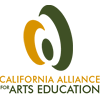Status of Arts Education in California Public Schools
The Status of Arts Education in California Public Schools, developed by the CA Alliance for Arts Education, can be used to inform yourself and key decision makers during this critical time for arts education in California.
The Arts Are Required Subjects in California Public Schools
The Visual and Performing Arts were added to the list of required subjects in the California Education Code in September 2000. This means that all California public schools must provide arts instruction to all of their students. Since 2001, the Visual and Performing Arts have been core subjects in our federal elementary and secondary education legislation, No Child Left Behind.
Visual and Performing Arts Standards and Framework
The California State Board of Education adopted Visual and Performing Arts Content Standards in January 2001, describing what every student should know and be able to do in the visual and performing arts in grades pre-K through 12.
The standards include dance, music, theater, and visual arts, and are divided into five strands within each discipline:
- artistic perception
- creative expression
- historical and cultural context
- aesthetic valuing
- connections, relationships and applications
The revised Visual and Performing Arts Framework for California Public Schools: Kindergarten through Grade Twelve was published in September 2004, and identifies key standards in each arts discipline.
Download the arts standards and framework at: http://www.cde.ca.gov/be/st/ss/index.asp.
Visual and Performing Arts Curricula
The State has adopted instructional materials in music and visual arts for grades K-8, and in dance, music, theatre, and visual arts for grades 9-12.
Current law allows school districts to use their instructional materials adoption funds for the visual and performing arts after purchasing materials for language arts (SB469 (Scott) 2003).
California University Admissions Requirements
The University of California and the California State University require the arts as a college preparatory subject for all high school students who wish to enter the state's higher education institutions.
By 2006, all students entering the UC/CSU system must satisfy the visual and performing arts requirement by completing an approved year-long, sequential course in dance, music, theatre or the visual arts that is aligned with the state arts standards.
Quality, Equity, and Access to Arts Education
Emphasis on reading and math in both state and federal accountability systems has an unintentional impact on the provision of instruction in the arts and other required subjects.
The quality and frequency of arts education in California public schools is highly inconsistent due to competing priorities and limited discretionary funding. As a result, arts participation varies greatly across the state, within districts and schools, and even within classrooms.
Disadvantaged and at-risk youth are often barred from school arts programs in favor of remedial instruction in reading and math. This practice contradicts research evidence that quality arts education provides even greater learning benefits to disadvantaged youth than their advantaged classmates.
Teacher Preparation in Arts Education
In 1970, passage of the Ryan Act eliminated art and music requirements for elementary teacher preparation. As a result, the vast majority of today’s K-8 classroom teachers have had little or no systematic preparation to introduce their students to the visual and performing arts.
In the 1980s and 1990s, independent teaching artists, parent volunteers, and educators from state and local arts organizations partially filled the arts gap in some schools on a limited basis.
In response to the State’s adoption of content standards in the arts, elementary teacher education programs in California are now required to provide a minimum level of arts methods coursework as of December 2004.
While single-subject credentials are available in music and the visual arts, dance and theatre educators must obtain credentials in physical education and English, respectively.
According to the California Department of Education, there are 8,305 full-time credentialed teachers of the arts, teaching 1,462,297 students in discipline-specific arts classes, representing only 23% of the State’s 6.3 million students.
Professional Development in Arts Education
The 35-year gap in elementary teacher preparation in the arts (1970-2004) created an entire generation of classroom teachers with little or no arts experience in their own K-16 education and preservice training.
No Child Left Behind places emphasis on “highly qualified teachers,” and has heightened awareness of the need for professional development in the arts for classroom teachers and arts specialists.
The California Arts Project (TCAP) is the designated statewide education agency that offers standards-based arts education professional development for classroom teachers. TCAP has regional offices serving local public school districts in their area. Funding for TCAP has been subject to state budgetary ebbs and flows. Learn more at: http://csmp.ucop.edu/tcap/
Professional development is also provided to classroom teachers, arts specialists, teaching artists, and school administrators in concentrated pockets throughout the State, primarily associated with private and federally funded initiatives such as those in Alameda, Los Angeles, San Francisco, and Santa Clara Counties.
Additional teacher training opportunities are provided by local school districts and arts organizations on a very limited basis.
Funding for Arts Education in California
Although it has been nearly 30 years since the passage of Proposition 13 – which cut local tax revenues for public schools and virtually eliminated arts programs – schools are still struggling to find a place in their budgets for the arts.
A 1997 study in Santa Clara County and a 2001 study in Los Angeles County both found that most local school districts allocated less than 2% of their annual budget to arts education. * While limited in number, most of the California districts that are working toward standards-based, systemic arts education programs rely heavily upon special initiatives funded by private or federal grants. In 2003, the top 10 foundations in the San Francisco Bay Area invested $14.3 million in arts education, with 47.4% dedicated to children and youth.
From 1999 through 2004, the California Department of Education administered a $6 million competitive grant program, Arts Work. Over 4 years, this program reached 47 of the 48 counties and 6 million students, and supported planning, implementation, and assessment of standards-based arts education programs. During 2004-06 California had no dedicated source of state funding for arts education.
The budget for 2006-07 included $105 million in Proposition 98 General Funds for an ongoing Arts and Music Block Grant program. These funds will be distributed to school districts, charter schools and county offices of education (programs) to support standards aligned instruction in kindergarten through grade twelve. It is the intent of the Governor and Legislature that these funds supplement, and not supplant, existing resources for the visual and performing arts (dance, music, theatre and visual arts).
The allocation will be based on an equal amount per pupil or school size, with a minimum of $2,500 for school sites with twenty or fewer students and a minimum of $4,000 per site with more than twenty students.
This funding may be used to:
- Hire additional staff (teachers and/or administrators.)
- Implement or increase staff development opportunities, as necessary to support standards-aligned visual and performing arts instruction.
- Purchase new materials, books, supplies, and equipment.
The 2005-06 The Budget also includes $500 million in Proposition 98 General Funds on a one-time basis for the purchase of arts, music and/or physical education supplies and equipment and professional development.
The allocation will equal the amount per unit of average daily attendance in kindergarten and grades one through twelve, with a minimum funding level of $2,500 for small schools.
The funding may be used to:
- Purchase visual and performing arts supplies and equipment.
- Purchase physical education supplies and equipment.
- Provide professional development in the visual and performing arts and physical education.
The 2007-2008 State budget includes over $109 million in ongoing Arts and Music Block Grants to support standards-aligned arts instruction in grades K-12.











